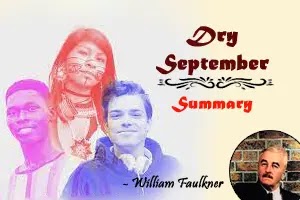Dry September by William Faulkner: Summary and Characters
"Dry September" is really a short story composed by William Faulkner, one of the foremost popular American pens of the 20th century. It was first published in 1931 as an excerpt of Faulkner's brief story collection" These 13."
👉 "Dry September" by William Faulkner: Introduction
The story is set in an imaginary city called Jefferson, set up within the southern United States. It shows the issues of ethnical weight, bias and the unsafe nature of chatter." Dry September" offers a close look into the social and ethical flux inside the people of South America within the early 20th century.
The central plot moves around a scuttlebutt that a black native man named Will Mayes has easily assaulted a white lady, Miss Minnie Cooper. The scuttlebutt spread like fleetly spreading fire through the city. It prompts the interface and impulses of the occupants. The story portrays the characters' responses to chatty treats, pressing their ethical insecurity, fear and capacity for brutality.
👉 The main characters in "Dry September"
1. Hawkshaw: He's the promoter and a hairstylist in Jefferson. Hawkshaw serves as a moral compass in the story, questioning the verity behind the scuttlebutt and prompting others to refrain from taking violent action.
2. Minnie Cooper: A partner who claims to have been assaulted by Will Mayes. Her allegation triggers the events of the story, although the verity of her blameworthiness remains nebulous.
3. Will Mayes: The indicted black man. He's portrayed as an unresisting and vulnerable character who becomes a target for the city's collaborative rage.
4. McLendon: A central figure in the mob intelligence that forms in response to the scuttlebutt. McLendon is depicted as a violent and racist existent who stokes the dears of ethnical abomination and leads the mob.
Through its pictorial depiction of the characters and their provocations," Dry September" offers a searing notice of ethnical prejudice, mob justice, and the destructive power of unsupported rumors. It's an important disquisition of the mortal condition and the dark swings that can crop in society.
👉 "Dry September" by William Faulkner: Summary
The story "Dry September" starts with a depiction of a hot, dry September evening. The townspeople meet at a nearby barbershop and have a casual discussion around later occasions. At the center of their contention may be a rumor approximately a dark man named Will Mayes who is denounced of assaulting a white lady named Miss Minnie Cooper.
Rumors spread rapidly and the townspeople got to be fretful. A gather of men led by a character named McLendon choose to require things into their possess hands. He accepts Mayes ought to be rebuffed for his charged violations, whether or not he is guilty.
A horde shapes and moves toward Mayes' house. On the way, they meet a dark man named Henry Hawkshaw, who tries to reason with them and address the legitimacy of the rumors. Be that as it may, his endeavors to calm the swarm are met with threatening vibe and threats.
When the horde comes to Mayes' domestic, they discover him sitting on his yard, uninformed of the approaching threat. McLendon gone up against Mayes and blamed him of ambush. Mayes challenges his blamelessness, but his words drop on hard of hearing ears. A swarm driven by dazzle seethe and racial bias assaulted them.
In the interim, the story switches to the viewpoint of a lady named Miss Minnie Cooper. She is depicted as a forlorn lady who is biting and rejected by men. His inspiration for convicting Mayes was addressed because it got to be clear that he had organized the assault to pick up consideration and sympathy.
As the assault on Mayes heighten, the story returns to Hawkshaw, who seen the terrible scene. He is torn between his ethical inner voice and his fear of going against the swarm. Within the conclusion, he feels feeble to halt the viciousness and chooses not to intervene.
After the swarm scatters, the story closes with a sense of result and lament. The townspeople start to address his activities and the results of his daze seethe. Realizing the degree of the harm caused by the mob's actions, McLendon is remorseful.
Dry September could be a effective examination of the dangerous nature of prejudice and the perilous results of horde mindset. Faulkner investigates the subjects of partiality, treachery, and dehumanization of individuals based on race. The story serves as a study of the social climate within the American South within the early 20th century and highlights the necessity for sympathy and soundness within the confront of mania and viciousness.
*****
Read also:
👉 Absalom and Achitophel | Dryden's art of characterization
👉 Absalom and Achitophel | majesty of the heroic poem with the bitterness of satire
👉 Paradise Lost Book-I | Milton’s use of epic similes
👉 T. S. Eliot’s concept of the Impersonal theory of poetry
👉 Aristotle's Poetics | views on the plot of tragedy and its relative importance




.webp)
.webp)












0 Comments
I'm pleased to hear from you. Without any hesitation, kindly leave your valuable words in the Comment Box